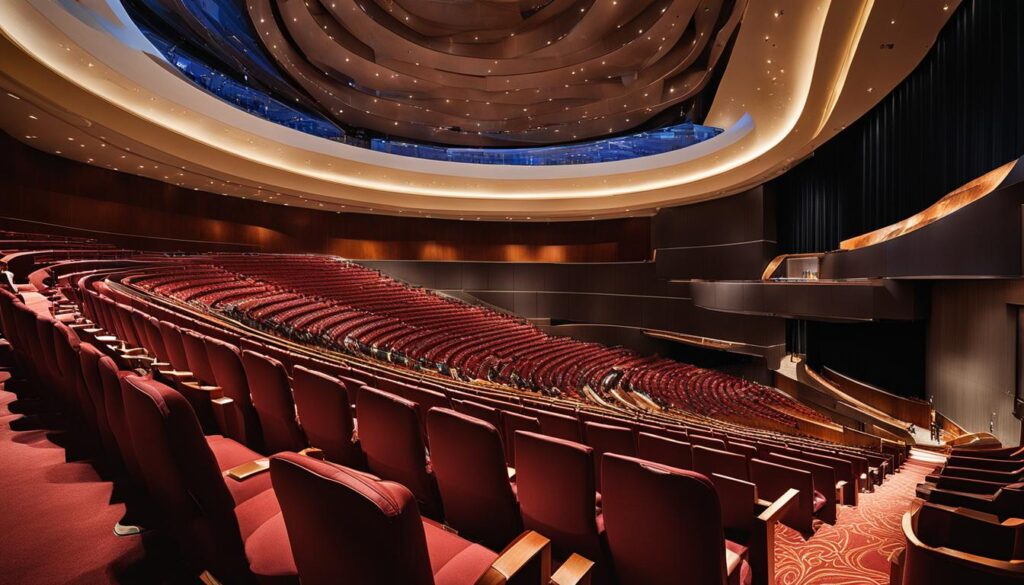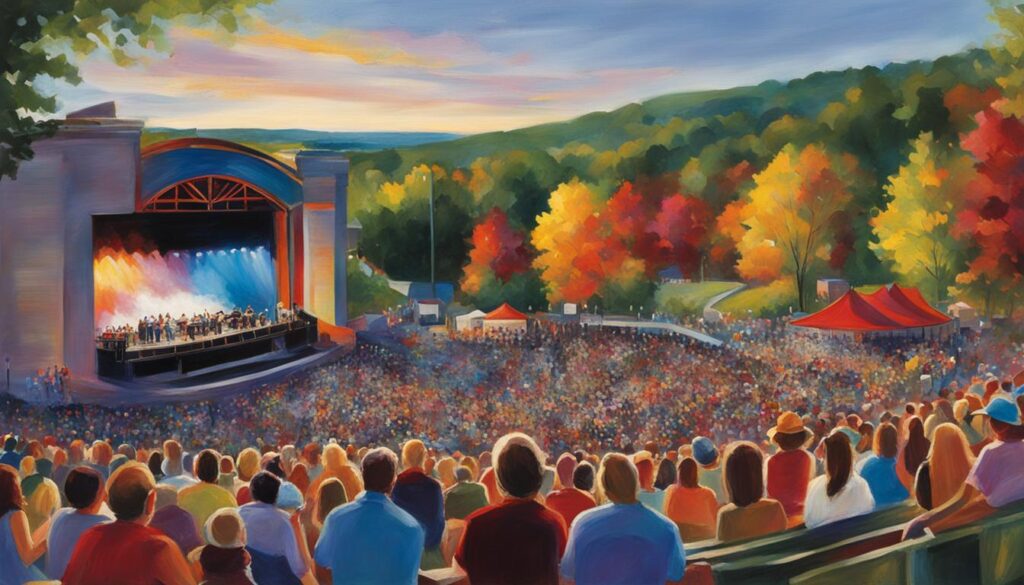Welcome to my blog where we will dive into the fascinating world of Hippodrome Theatres. Have you ever wondered what exactly a Hippodrome Theatre is? Well, you’ve come to the right place! In this article, we will explore the definition, history, and importance of these unique venues that have been captivating audiences for decades.
So, what exactly is a Hippodrome Theatre? Simply put, it is a venue that showcases a wide range of performing arts events. From concerts and festivals to comedy nights and more, Hippodrome Theatres are spaces where artists from various genres come together to entertain and engage audiences. The term “hippodrome” originates from the Greek word for “racecourse”, as these theatres were originally circular or oval-shaped buildings used for equestrian events. However, over time, the meaning has evolved to encompass a diverse array of artistic performances.
Key Takeaways:
- A Hippodrome Theatre is a venue that hosts a variety of performing arts events.
- The term “hippodrome” comes from the Greek word for “racecourse”.
- Hippodrome theatres have a rich history and contribute to the cultural fabric of communities.
- They are known for their unique architecture and grandeur.
- These venues provide a platform for artists to showcase their talent and connect with audiences.
The History of Hippodrome Theatres
Hippodrome theatres have a long and storied history. Originating in the late 19th and early 20th centuries, these iconic venues played a significant role in the entertainment industry. The term “hippodrome” refers to a circular or oval-shaped building used for equestrian events, but over time, it has evolved to include a wide range of artistic performances.
Some of the most famous hippodrome theatres were built during this time, leaving a lasting impact on the cultural fabric of communities. The Hippodrome Theatre in Baltimore, Maryland, is a prime example. Known for its grand architectural design and lavish productions, it has become a landmark in the city. The London Hippodrome also stands as a testament to the rich history of hippodrome theatres. Originally a circus venue, it has transformed into a thriving entertainment complex.
These theatres were at the forefront of the entertainment industry, hosting vaudeville shows, musical revues, and even early motion picture screenings. They were the center of cultural life in their respective cities, attracting both locals and tourists with their captivating performances. Today, while some iconic hippodrome theatres have stood the test of time, modern venues continue to carry on the legacy, adapting to the needs of contemporary artists and audiences.
Famous Hippodrome Theatres
| Hippodrome Theatre | Location | Architectural Features |
|---|---|---|
| Hippodrome Theatre, Baltimore | Baltimore, Maryland | Grand architectural design, stunning facade |
| London Hippodrome | London, United Kingdom | Former circus venue, transformed into an entertainment complex |
| New York Hippodrome Theatre | New York City, New York | Once the largest theatre in the world, hosted spectacular productions |
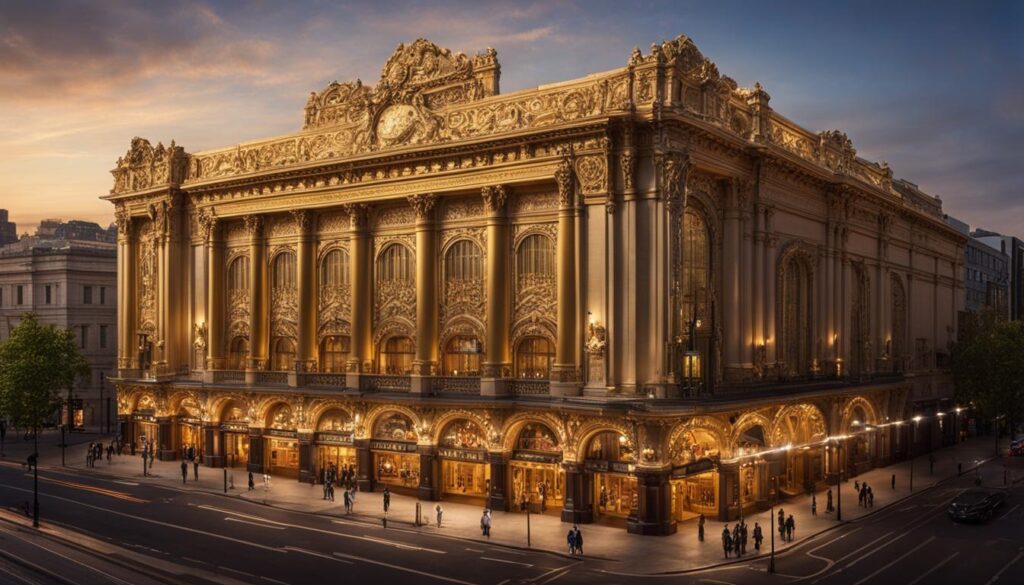

“Hippodrome theatres have left a lasting impact on the performing arts, attracting audiences with their grandeur and captivating performances.”
In conclusion, the history of hippodrome theatres is filled with grandeur and cultural significance. From their origins as equestrian event spaces to becoming centers of entertainment, these venues continue to shape the performing arts landscape. Famous hippodrome theatres like the ones mentioned above have become cultural landmarks, inspiring artists and creating memorable experiences for audiences around the world.
The Architecture of Hippodrome Theatres
Hippodrome theatres are renowned not only for their captivating performances but also for their stunning architectural designs. These iconic venues are characterized by their grandeur and attention to detail, creating a truly immersive and magical experience for audiences. The architecture of hippodrome theatres often incorporates elements from the Beaux-Arts style, which was popular during the late 19th and early 20th centuries. This style emphasizes symmetry, ornate facades, and intricate interior decorations.
One of the most notable features of hippodrome theatres is their unique circular or oval-shaped design, reminiscent of the original racecourses that inspired their name. This layout ensures that every seat in the house offers excellent views of the stage, allowing audiences to fully immerse themselves in the performances. The interiors of these theatres often boast luxurious decorations, including intricate plasterwork, elaborate ceiling designs, and opulent chandeliers. The combination of these architectural elements creates an ambiance of elegance and grandeur, further enhancing the overall theatrical experience.
“The architecture of hippodrome theatres is a true testament to the craftsmanship and artistic vision of their creators. These iconic venues not only provide a space for artists to showcase their talent but also serve as works of art in themselves.”
In recent years, modern hippodrome theatres have embraced the grand architectural tradition while incorporating contemporary elements and technologies. These venues incorporate advanced sound systems, state-of-the-art lighting equipment, and innovative stage designs to enhance the audience’s sensory experience. Renovations to historic hippodrome theatres often focus on preserving their unique architectural charm while adapting to the needs of modern performers and audiences.
Table: Examples of Iconic Hippodrome Theatres
| Name | Location | Architectural Style | Notable Features |
|---|---|---|---|
| Hippodrome Theatre | Baltimore, Maryland | Beaux-Arts | Distinct circular design, ornate interior decorations |
| London Hippodrome | London, United Kingdom | Neo-Classical | Impressive dome, iconic facade |
| New York Hippodrome Theatre | New York City, New York | Beaux-Arts | Largest theatre in the world at the time, lavish productions |
The architecture of hippodrome theatres continues to be a symbol of artistic expression and cultural significance. These remarkable venues not only stand as architectural marvels but also provide a stage for creativity, entertainment, and the celebration of the performing arts. Whether showcasing historic charm or embracing modern innovations, hippodrome theatres captivate audiences and leave a lasting impression.
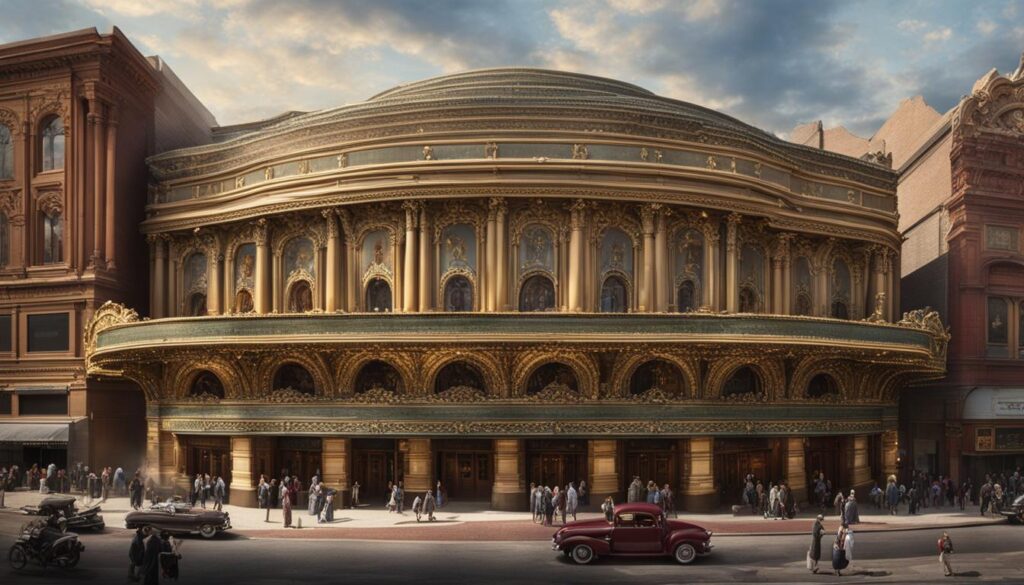

The Importance of Hippodrome Theatres
Hippodrome theatres play a vital role in the cultural fabric of communities, providing a platform for artists to showcase their talent and connect with audiences. These venues offer a diverse range of programming, catering to different tastes and interests. From musical performances to theatrical productions, comedy shows to dance recitals, there is something for everyone at a hippodrome theatre.
One of the key reasons why hippodrome theatres are important is their contribution to the local economy. These venues attract visitors from near and far, resulting in increased revenue for surrounding businesses such as restaurants, hotels, and retail stores. Additionally, the presence of a thriving hippodrome theatre creates job opportunities in the arts and entertainment industry, benefiting local artists, technicians, and support staff.
Furthermore, hippodrome theatres serve as gathering places where people can come together to share in the joy of live performances. Whether it’s attending a concert by a favorite artist or experiencing the magic of a ballet performance, these venues create lasting memories for audiences of all ages. The communal aspect of enjoying a live show in the presence of others fosters a sense of connection and shared appreciation for the arts.
The Impact of Hippodrome Theatres on Education
In addition to their entertainment value, hippodrome theatres also play a crucial role in education. Many of these venues offer educational programs and workshops for students, exposing them to the performing arts and nurturing their creativity. Through school field trips and outreach initiatives, young minds are inspired and given the opportunity to explore their artistic potential.
Overall, the importance of hippodrome theatres cannot be understated. They serve as cultural beacons, enriching communities with art, entertainment, and a sense of togetherness. Whether preserving historic charm or embracing modern innovations, hippodrome theatres continue to be cherished and valued as integral parts of our society.
Table: The Economic Impact of Hippodrome Theatres
| Categories | Impact |
|---|---|
| Increased Tourism | Attracts visitors from near and far, boosting local tourism revenue |
| Job Creation | Creates employment opportunities in the arts and entertainment industry |
| Support for Local Businesses | Generates revenue for surrounding restaurants, hotels, and retail stores |
Famous Hippodrome Theatres Around the World
Hippodrome theatres have left a lasting impact on the performing arts scene, and several venues stand out as famous landmarks in the industry. These theatres have not only showcased incredible performances but have also become cultural icons in their respective cities.
Baltimore Hippodrome Theatre
The Baltimore Hippodrome Theatre, located in Maryland, is one of the most famous hippodrome theatres in the world. Built in 1914, this historic venue has a rich history and has hosted countless notable performances. With its stunning Beaux-Arts architecture and luxurious interior, the Baltimore Hippodrome Theatre continues to attract audiences from far and wide.
London Hippodrome
The London Hippodrome, situated in the heart of the West End, is another renowned hippodrome theatre. Originally built as a circus venue in 1900, it has undergone several transformations throughout the years. Today, the London Hippodrome stands as a thriving entertainment complex, showcasing a variety of performances, including musicals, comedy shows, and live music concerts.
New York Hippodrome Theatre
The New York Hippodrome Theatre, often referred to as the “largest theatre in the world,” was a legendary venue in Times Square. Although it is no longer in existence, it played a pivotal role in the history of hippodrome theatres. The New York Hippodrome Theatre was known for its grandeur and hosted extravagant productions, attracting thousands of spectators during its prime.
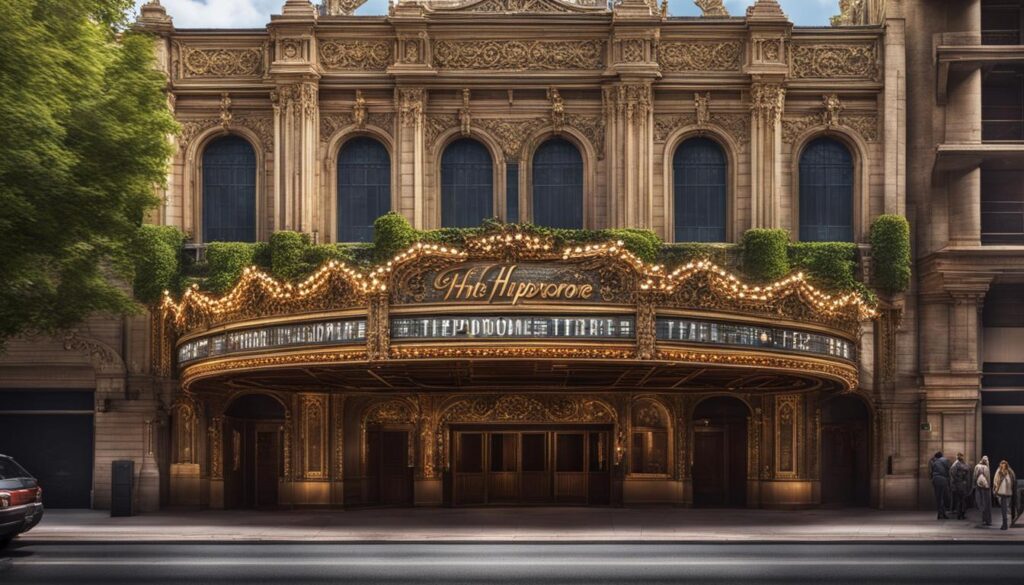

These are just a few examples of the famous hippodrome theatres that have left a lasting impression on the performing arts world. Each venue has its unique charm and history, contributing to the vibrant cultural fabric of their respective cities.
Conclusion
As I wrap up this exploration of hippodrome theatres, it’s clear that these magnificent venues hold a special place in the performing arts world. From their rich history to their captivating architecture, modern hippodrome theatres continue to play a vital role in our cultural landscape.
Today, they have evolved to embrace contemporary elements while preserving their historic charm. These theatres provide a platform for artists to showcase their talent and connect with audiences, offering a diverse range of programming that caters to varied tastes and interests.
But the importance of hippodrome theatres goes beyond entertainment. They contribute to the local economy, attracting visitors, supporting local businesses, and creating job opportunities in the arts and entertainment industry. Perhaps most importantly, they serve as gathering places where people can come together to experience the magic of live performances and create cherished memories.
In a world dominated by virtual experiences, the enduring allure of the hippodrome theatre stands as a testament to the power of live performance. Whether it’s witnessing a breathtaking musical, laughing at a comedy show, or being moved by a thought-provoking play, the modern hippodrome theatre continues to captivate audiences and shape the cultural fabric of our communities.
FAQ
What is a hippodrome theatre?
A hippodrome theatre is a venue that showcases a variety of performing arts events, including concerts, festivals, comedy nights, and more. It is a space where artists from different genres come together to entertain and engage audiences.
Where does the term “hippodrome” originate from?
The term “hippodrome” originates from the Greek word for “racecourse” and was originally used to describe a circular or oval-shaped building used for equestrian events. Over time, the meaning has evolved to encompass a wide range of artistic performances.
What is the history of hippodrome theatres?
Hippodrome theatres first gained popularity in the late 19th and early 20th centuries. Some famous examples include the Hippodrome Theatre in Baltimore, Maryland, the London Hippodrome, and the Hippodrome Theatre in New York City. These venues were known for their grand architectural designs and lavish productions.
What is the architecture of hippodrome theatres like?
The architecture of hippodrome theatres is characterized by its grandeur and attention to detail. These venues often feature ornate facades, intricate interior decorations, and state-of-the-art stage equipment. Many hippodrome theatres were designed in the Beaux-Arts style, which was popular during the late 19th and early 20th centuries.
What is the importance of hippodrome theatres?
Hippodrome theatres provide a platform for artists to showcase their talent and connect with audiences. They contribute to the local economy by attracting visitors, supporting local businesses, and creating job opportunities in the arts and entertainment industry. Moreover, these venues serve as gathering places where people can come together to share in the joy of live performances and create lasting memories.
Can you name some famous hippodrome theatres around the world?
Some famous hippodrome theatres include the Hippodrome Theatre in Baltimore, Maryland, the London Hippodrome, and the New York Hippodrome Theatre. These venues have become cultural landmarks and continue to inspire artists and audiences alike.
